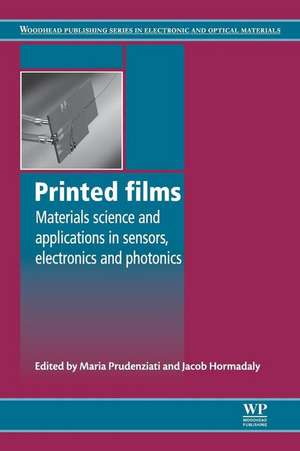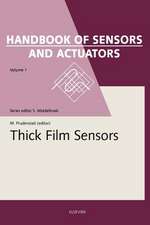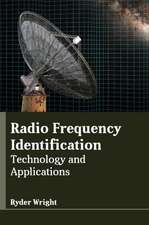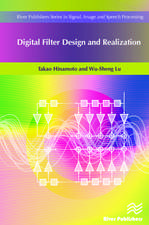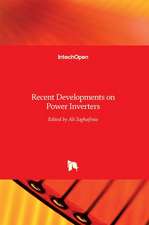Printed Films: Materials Science and Applications in Sensors, Electronics and Photonics: Woodhead Publishing Series in Electronic and Optical Materials
Editat de Maria Prudenziati, Jacob Hormadalyen Limba Engleză Paperback – 18 aug 2016
Materials and properties of printed films are the focus of part one, beginning with a review of the concepts, technologies and materials involved in their production and use. Printed films as electrical components and silicon metallization for solar cells are discussed, as are conduction mechanisms in printed film resistors, and thick films in packaging and microelectronics. Part two goes on to review the varied applications of printed films in devices. Printed resistive sensors are considered, as is the role of printed films in capacitive, piezoelectric and pyroelectric sensors, mechanical micro-systems and gas sensors. The applications of printed films in biosensors, actuators, heater elements, varistors and polymer solar cells are then explored, followed by a review of screen printing for the fabrication of solid oxide fuel cells and laser printed micro- and meso-scale power generating devices.
With its distinguished editors and international team of expert contributors, Printed films is a key text for anyone working in such fields as microelectronics, fuel cell and sensor technology in both industry and academia.
- Provides a comprehensive analysis of the most significant recent developments in printed films and their applications
- Reviews the concepts, properties, technologies and materials involved in the production and use of printed films
- Analyses the varied applications of printed films in devices, including printed restrictive sensors for physical quantities and printed thick film mechanical micro-systems (MEMS), among others
Din seria Woodhead Publishing Series in Electronic and Optical Materials
- 24%
 Preț: 1160.66 lei
Preț: 1160.66 lei - 18%
 Preț: 1299.95 lei
Preț: 1299.95 lei - 39%
 Preț: 1136.44 lei
Preț: 1136.44 lei - 9%
 Preț: 912.54 lei
Preț: 912.54 lei - 9%
 Preț: 956.68 lei
Preț: 956.68 lei - 24%
 Preț: 951.04 lei
Preț: 951.04 lei - 9%
 Preț: 1335.64 lei
Preț: 1335.64 lei - 29%
 Preț: 986.78 lei
Preț: 986.78 lei - 24%
 Preț: 874.56 lei
Preț: 874.56 lei - 29%
 Preț: 1075.95 lei
Preț: 1075.95 lei - 29%
 Preț: 1414.77 lei
Preț: 1414.77 lei - 9%
 Preț: 1216.61 lei
Preț: 1216.61 lei - 39%
 Preț: 811.62 lei
Preț: 811.62 lei - 29%
 Preț: 1193.77 lei
Preț: 1193.77 lei - 9%
 Preț: 1444.32 lei
Preț: 1444.32 lei - 24%
 Preț: 926.89 lei
Preț: 926.89 lei - 9%
 Preț: 1107.16 lei
Preț: 1107.16 lei - 9%
 Preț: 1262.45 lei
Preț: 1262.45 lei - 9%
 Preț: 954.69 lei
Preț: 954.69 lei - 9%
 Preț: 1006.73 lei
Preț: 1006.73 lei - 9%
 Preț: 958.65 lei
Preț: 958.65 lei - 9%
 Preț: 948.72 lei
Preț: 948.72 lei - 9%
 Preț: 1150.61 lei
Preț: 1150.61 lei - 23%
 Preț: 1493.72 lei
Preț: 1493.72 lei - 9%
 Preț: 950.94 lei
Preț: 950.94 lei - 24%
 Preț: 1276.29 lei
Preț: 1276.29 lei - 29%
 Preț: 1333.73 lei
Preț: 1333.73 lei - 9%
 Preț: 901.22 lei
Preț: 901.22 lei - 9%
 Preț: 1130.18 lei
Preț: 1130.18 lei - 9%
 Preț: 1049.49 lei
Preț: 1049.49 lei - 24%
 Preț: 871.12 lei
Preț: 871.12 lei - 27%
 Preț: 1459.23 lei
Preț: 1459.23 lei - 20%
 Preț: 1071.49 lei
Preț: 1071.49 lei - 24%
 Preț: 932.11 lei
Preț: 932.11 lei - 29%
 Preț: 1071.64 lei
Preț: 1071.64 lei - 24%
 Preț: 670.36 lei
Preț: 670.36 lei - 9%
 Preț: 926.48 lei
Preț: 926.48 lei - 23%
 Preț: 929.43 lei
Preț: 929.43 lei - 9%
 Preț: 897.50 lei
Preț: 897.50 lei - 9%
 Preț: 1276.81 lei
Preț: 1276.81 lei - 9%
 Preț: 957.63 lei
Preț: 957.63 lei - 29%
 Preț: 845.10 lei
Preț: 845.10 lei - 9%
 Preț: 953.05 lei
Preț: 953.05 lei - 33%
 Preț: 1126.67 lei
Preț: 1126.67 lei - 29%
 Preț: 954.77 lei
Preț: 954.77 lei - 24%
 Preț: 961.16 lei
Preț: 961.16 lei - 23%
 Preț: 930.29 lei
Preț: 930.29 lei - 23%
 Preț: 1080.19 lei
Preț: 1080.19 lei
Preț: 1077.09 lei
Preț vechi: 1183.61 lei
-9% Nou
Puncte Express: 1616
Preț estimativ în valută:
206.13€ • 214.41$ • 170.17£
206.13€ • 214.41$ • 170.17£
Carte tipărită la comandă
Livrare economică 05-19 aprilie
Preluare comenzi: 021 569.72.76
Specificații
ISBN-13: 9780081016572
ISBN-10: 0081016573
Pagini: 608
Dimensiuni: 156 x 234 x 31 mm
Greutate: 0.84 kg
Editura: ELSEVIER SCIENCE
Seria Woodhead Publishing Series in Electronic and Optical Materials
ISBN-10: 0081016573
Pagini: 608
Dimensiuni: 156 x 234 x 31 mm
Greutate: 0.84 kg
Editura: ELSEVIER SCIENCE
Seria Woodhead Publishing Series in Electronic and Optical Materials
Cuprins
Contributor contact details
Woodhead Publishing Series in Electronic and Optical Materials
Dedication
Preface
Part I: Materials and properties of printed films
Chapter 1: Technologies for printed films
Abstract:
1.1 Introduction: printed films in microelectronics
1.2 From thick-films and hybrids to printed electronics
1.3 Other systems
1.4 Conclusion
Chapter 2: Materials for printed films
Abstract:
2.1 Introduction
2.2 Active phases
2.3 Deposition medium – vehicle
2.4 Glasses and glass ceramics
2.5 Substrates
2.6 Conclusion
Chapter 3: Materials Science concepts for printed films
Abstract:
3.1 Introduction
3.2 Interactions of conducting materials with the organic vehicle at room temperature
3.3 Redox reactions
3.4 Chemical diffusion-related interactions during the firing cycle
3.5 Sintering, grain growth and Ostwald ripening
3.6 Reactivity interactions in other systems
3.7 The Kirkendall effect
3.8 Conclusions and future trends
Chapter 4: Properties of printed films as electrical components and metallization of solar cells
Abstract:
4.1 Introduction
4.2 Thick-film resistors
4.3 Conductors
4.4 Dielectrics
Chapter 5: Conduction mechanisms in printed thick-film resistors
Abstract:
5.1 Introduction
5.2 Current understanding of the conduction mechanism in thick-film resistors
5.3 Conclusion and future trends
Chapter 6: Multilayer low-temperature co-fired ceramic systems incorporating a thick-film printing process
Abstract:
6.1 Introduction
6.2 Low-temperature co-fired ceramics (LTCC) compositions
6.3 LTCC manufacturing methods
6.4 An overview of LTCC applications
6.5 Future trends
6.6 Sources of further information
Part II: Applications of printed films in devices
Chapter 7: Printed resistive sensors for physical quantities
Abstract:
7.1 Introduction
7.2 Temperature sensors
7.3 Piezoresistive properties and related sensors
7.4 Magnetoresistive effects and sensors
7.5 Radiant sensors
7.6 Potentiometric sensors
7.7 Conclusion and future trends
Chapter 8: Printed thick-film capacitive sensors
Abstract:
8.1 Introduction
8.2 General concepts
8.3 Configurations and technologies
8.4 Capacitive sensing based on geometrical variations
8.5 Capacitive sensing based on permittivity variations
8.6 Examples of devices and their applications
8.7 Conclusion and future trends
8.8 Sources of further information
Chapter 9: Printed thick-film piezoelectric and pyroelectric sensors
Abstract:
9.1 Introduction
9.2 Piezoelectricity, pyroelectricity and ferroelectricity
9.3 Basic theory and relationships of the piezoelectric effect
9.4 Thick-films based on ferroelectric inorganic compounds
9.5 Piezoelectric sensors
9.6 Pyroelectric sensors
9.7 Future trends
9.8 Sources of further information
9.9 Acknowledgments
Chapter 10: Printed thick-film mechanical microsystems (MEMS)
Abstract:
10.1 Introduction
10.2 Printed films with silicon MEMS
10.3 Printed films with ceramic MEMS
10.4 Conclusion and future trends
Chapter 11: Printed semiconducting gas sensors
Abstract
11.1 Introduction
11.2 Principles of operation and modeling
11.3 Functional materials
11.4 Morphological, structural and electrical properties
11.5 Applications
11.6 Future trends
11.7 Acknowledgments
Chapter 12: Printed gas sensors based on electrolytes
Abstract:
12.1 Introduction
12.2 Solid electrolytes
12.3 Potentiometric sensors
12.4 Thermodynamically controlled sensors
12.5 Sensors controlled by both thermodynamics and kinetics
12.6 Amperometric sensors
12.7 NOx sensing device, associating upstream oxygen pumping with potentiometric and amperometric operating principles
12.8 Conclusion and possible future trends
Chapter 13: Printed thick-film biosensors
Abstract:
13.1 Introduction
13.2 Pharmaceutical and medical applications of thick-film biosensors
13.3 Environmental applications of screen-printed electrodes
13.4 Conclusions
13.6 Acknowledgements
Chapter 14: Printed actuators
Abstract:
14.1 Introduction
14.2 Films as actuators
14.3 Actuation mechanisms
14.4 Piezoelectric actuators
14.5 Piezoelectric actuator fabrication
14.6 Processing–properties–microstructure interrelationship
14.7 Conclusion and future trends
Chapter 15: Printed heater elements
Abstract:
15.1 Introduction
15.2 Materials for heater fabrication
15.3 Heater designs
15.4 Heaters for sensor and actuator applications
15.5 Conclusion
Chapter 16: Screen-printing for the fabrication of solid oxide fuel cells (SOFC)
Abstract:
16.1 Introduction
16.2 Fuel cells: principle, types and challenges (Hoogers, 2003; Larminie, 2000)
16.3 Electrolytes
16.4 Electrodes
16.5 Single-chamber SOFCs
16.6 Micro single-chamber SOFCs
16.7 Conclusion and trends
Chapter 17: Printed varistors
Abstract:
17.1 Introduction
17.2 The varistor action
17.3 Composition, preparation and microstructure of ceramic ZnO-based varistors
17.4 Printing process in varistors fabrication
17.5 Multilayer varistors
17.6 Screen-printed and fired thick-film varistors
17.7 Progress in the development of ZnO-based thick-films and tape-casted varistors
17.8 Microstructural and electrical characterization of ZnO-based varistors prepared by screen printing and tape casting
17.9 Conclusion
17.10 Acknowledgements
Chapter 18: Laser-printed micro- and meso-scale power generating devices
Abstract:
18.1 Introduction
18.2 Background to laser-induced forward transfer (LIFT)
18.3 Laser transfer of complex rheological systems
18.4 Laser-printed micro-power sources
18.5 Laser-printed embedded micro-power sources
18.6 Challenges and opportunities
18.7 Conclusion and future trends
18.8 Acknowledgements
Chapter 19: Printed polymer solar cells
Abstract:
19.1 Introduction
19.2 Printing and coating methods
19.3 Manufacturing methods for complete polymer solar cells
19.4 Applications and demonstrations of polymer solar cells
19.5 Conclusions and future trends
19.6 Acknowledgements
Index
Woodhead Publishing Series in Electronic and Optical Materials
Dedication
Preface
Part I: Materials and properties of printed films
Chapter 1: Technologies for printed films
Abstract:
1.1 Introduction: printed films in microelectronics
1.2 From thick-films and hybrids to printed electronics
1.3 Other systems
1.4 Conclusion
Chapter 2: Materials for printed films
Abstract:
2.1 Introduction
2.2 Active phases
2.3 Deposition medium – vehicle
2.4 Glasses and glass ceramics
2.5 Substrates
2.6 Conclusion
Chapter 3: Materials Science concepts for printed films
Abstract:
3.1 Introduction
3.2 Interactions of conducting materials with the organic vehicle at room temperature
3.3 Redox reactions
3.4 Chemical diffusion-related interactions during the firing cycle
3.5 Sintering, grain growth and Ostwald ripening
3.6 Reactivity interactions in other systems
3.7 The Kirkendall effect
3.8 Conclusions and future trends
Chapter 4: Properties of printed films as electrical components and metallization of solar cells
Abstract:
4.1 Introduction
4.2 Thick-film resistors
4.3 Conductors
4.4 Dielectrics
Chapter 5: Conduction mechanisms in printed thick-film resistors
Abstract:
5.1 Introduction
5.2 Current understanding of the conduction mechanism in thick-film resistors
5.3 Conclusion and future trends
Chapter 6: Multilayer low-temperature co-fired ceramic systems incorporating a thick-film printing process
Abstract:
6.1 Introduction
6.2 Low-temperature co-fired ceramics (LTCC) compositions
6.3 LTCC manufacturing methods
6.4 An overview of LTCC applications
6.5 Future trends
6.6 Sources of further information
Part II: Applications of printed films in devices
Chapter 7: Printed resistive sensors for physical quantities
Abstract:
7.1 Introduction
7.2 Temperature sensors
7.3 Piezoresistive properties and related sensors
7.4 Magnetoresistive effects and sensors
7.5 Radiant sensors
7.6 Potentiometric sensors
7.7 Conclusion and future trends
Chapter 8: Printed thick-film capacitive sensors
Abstract:
8.1 Introduction
8.2 General concepts
8.3 Configurations and technologies
8.4 Capacitive sensing based on geometrical variations
8.5 Capacitive sensing based on permittivity variations
8.6 Examples of devices and their applications
8.7 Conclusion and future trends
8.8 Sources of further information
Chapter 9: Printed thick-film piezoelectric and pyroelectric sensors
Abstract:
9.1 Introduction
9.2 Piezoelectricity, pyroelectricity and ferroelectricity
9.3 Basic theory and relationships of the piezoelectric effect
9.4 Thick-films based on ferroelectric inorganic compounds
9.5 Piezoelectric sensors
9.6 Pyroelectric sensors
9.7 Future trends
9.8 Sources of further information
9.9 Acknowledgments
Chapter 10: Printed thick-film mechanical microsystems (MEMS)
Abstract:
10.1 Introduction
10.2 Printed films with silicon MEMS
10.3 Printed films with ceramic MEMS
10.4 Conclusion and future trends
Chapter 11: Printed semiconducting gas sensors
Abstract
11.1 Introduction
11.2 Principles of operation and modeling
11.3 Functional materials
11.4 Morphological, structural and electrical properties
11.5 Applications
11.6 Future trends
11.7 Acknowledgments
Chapter 12: Printed gas sensors based on electrolytes
Abstract:
12.1 Introduction
12.2 Solid electrolytes
12.3 Potentiometric sensors
12.4 Thermodynamically controlled sensors
12.5 Sensors controlled by both thermodynamics and kinetics
12.6 Amperometric sensors
12.7 NOx sensing device, associating upstream oxygen pumping with potentiometric and amperometric operating principles
12.8 Conclusion and possible future trends
Chapter 13: Printed thick-film biosensors
Abstract:
13.1 Introduction
13.2 Pharmaceutical and medical applications of thick-film biosensors
13.3 Environmental applications of screen-printed electrodes
13.4 Conclusions
13.6 Acknowledgements
Chapter 14: Printed actuators
Abstract:
14.1 Introduction
14.2 Films as actuators
14.3 Actuation mechanisms
14.4 Piezoelectric actuators
14.5 Piezoelectric actuator fabrication
14.6 Processing–properties–microstructure interrelationship
14.7 Conclusion and future trends
Chapter 15: Printed heater elements
Abstract:
15.1 Introduction
15.2 Materials for heater fabrication
15.3 Heater designs
15.4 Heaters for sensor and actuator applications
15.5 Conclusion
Chapter 16: Screen-printing for the fabrication of solid oxide fuel cells (SOFC)
Abstract:
16.1 Introduction
16.2 Fuel cells: principle, types and challenges (Hoogers, 2003; Larminie, 2000)
16.3 Electrolytes
16.4 Electrodes
16.5 Single-chamber SOFCs
16.6 Micro single-chamber SOFCs
16.7 Conclusion and trends
Chapter 17: Printed varistors
Abstract:
17.1 Introduction
17.2 The varistor action
17.3 Composition, preparation and microstructure of ceramic ZnO-based varistors
17.4 Printing process in varistors fabrication
17.5 Multilayer varistors
17.6 Screen-printed and fired thick-film varistors
17.7 Progress in the development of ZnO-based thick-films and tape-casted varistors
17.8 Microstructural and electrical characterization of ZnO-based varistors prepared by screen printing and tape casting
17.9 Conclusion
17.10 Acknowledgements
Chapter 18: Laser-printed micro- and meso-scale power generating devices
Abstract:
18.1 Introduction
18.2 Background to laser-induced forward transfer (LIFT)
18.3 Laser transfer of complex rheological systems
18.4 Laser-printed micro-power sources
18.5 Laser-printed embedded micro-power sources
18.6 Challenges and opportunities
18.7 Conclusion and future trends
18.8 Acknowledgements
Chapter 19: Printed polymer solar cells
Abstract:
19.1 Introduction
19.2 Printing and coating methods
19.3 Manufacturing methods for complete polymer solar cells
19.4 Applications and demonstrations of polymer solar cells
19.5 Conclusions and future trends
19.6 Acknowledgements
Index
